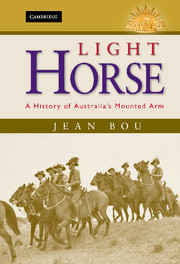Book contents
- Frontmatter
- CONTENTS
- List of maps
- ACKNOWLEDGEMENTS
- AUTHOR'S NOTE
- ABBREVIATIONS
- INTRODUCTION
- CHAPTER 1 ANCESTORS
- CHAPTER 2 TOUGH LESSONS
- CHAPTER 3 THE HUTTON ERA
- CHAPTER 4 UNFULFILLED PROMISE
- CHAPTER 5 THE LIGHT-HORSEMEN 1
- CHAPTER 6 MOUNTED RIFLES
- 7 CAVALRY
- CHAPTER 8 THE LIGHT-HORSEMEN 2
- CHAPTER 9 THE FINAL YEARS
- CONCLUSION
- EPILOGUE
- APPENDIX THE ‘BEERSHEBA CHARGE PHOTO’
- Notes
- BIBLIOGRAPHY
- INDEX
CHAPTER 9 - THE FINAL YEARS
The light horse at home, 1921–44
Published online by Cambridge University Press: 05 July 2014
- Frontmatter
- CONTENTS
- List of maps
- ACKNOWLEDGEMENTS
- AUTHOR'S NOTE
- ABBREVIATIONS
- INTRODUCTION
- CHAPTER 1 ANCESTORS
- CHAPTER 2 TOUGH LESSONS
- CHAPTER 3 THE HUTTON ERA
- CHAPTER 4 UNFULFILLED PROMISE
- CHAPTER 5 THE LIGHT-HORSEMEN 1
- CHAPTER 6 MOUNTED RIFLES
- 7 CAVALRY
- CHAPTER 8 THE LIGHT-HORSEMEN 2
- CHAPTER 9 THE FINAL YEARS
- CONCLUSION
- EPILOGUE
- APPENDIX THE ‘BEERSHEBA CHARGE PHOTO’
- Notes
- BIBLIOGRAPHY
- INDEX
Summary
The light horse units sent overseas as part of the AIF had earned themselves tremendous experience and great laurels, but with the end of the war the focus of military efforts had, once again, to become the militia at home. When the time for the necessary home force reorganisation finally came it was these strained and beleaguered units that were to form the basis of the Australian Military Forces during the austere and difficult interwar years. These years would see the role of the light horse change to reflect the lessons of the war and a failure, due to constrained resources and an apparent unwillingness to address mounted troop modernisation, to prepare the light horse adequately for the next war.
The 1920s
As highlighted in chapter 4 the militia light horse was in poor shape by the end of the First World War, and it was also clear that the militia as a whole was going to require significant reform if it were to make a useful contribution to the nation's post-war defence. The Military Board had considered the matter as early as January 1919 when it suggested to the government that a 300 000-man citizen force – which included 26 light horse regiments in two divisions and another 12 squadrons of divisional cavalry – was a suitable goal. For a government that had just spent a great deal of the nation's coin on the war (and would continue to do so for some time yet to pay its loans) this was too much, and instead it commissioned the Victorian politician George Swinburne to chair a committee of enquiry into the matter. He proposed a force of 180 000 in which the mounted branch would again have two divisions. Yet Swinburne's report did not find favour either, and it was another committee, this one of senior officers, formed in 1920 under the chairmanship of Lieutenant-General Sir Harry Chauvel, that would attempt to set the tone for the interwar years.
- Type
- Chapter
- Information
- Light HorseA History of Australia's Mounted Arm, pp. 227 - 255Publisher: Cambridge University PressPrint publication year: 2009

